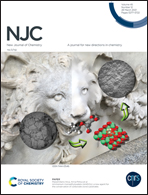Hemicellulose-triggered high-yield synthesis of carbon dots from biomass†
Abstract
Biomass is a major resource for the preparation of carbon dots (CDs) and improving the production yield of CDs is a challenge. Herein, we select corn cobs as cheap, abundant, and renewable biomass to prepare CDs with a production yield as high as 55%. Through studying the main components (cellulose, hemicellulose, and lignin) of a corn cob, we determine that such a high yield is derived from the high content of hemicellulose and extremely low lignin content of the corn cob. This indicates that hemicellulose is beneficial to the formation of CDs during the hydrothermal process, while cellulose and hemicellulose are not. This mechanism is further verified using four other biomass sources (linen stalks, coir fibres, peanut shells, and bamboos) with different cellulose, hemicellulose, and lignin contents. Based on fluorescence quenching, the prepared CDs display excellent feasibility for Fe3+ selective detection with a good linear correlation ranging from 0 to 120 μM. This work reveals the effects of cellulose, hemicellulose, and lignin biomass on CDs thus providing a novel strategy for the selection of a precursor and large-scale preparation of CDs, laying the groundwork for the industrial synthesis and application of CDs.



 Please wait while we load your content...
Please wait while we load your content...